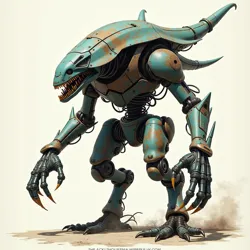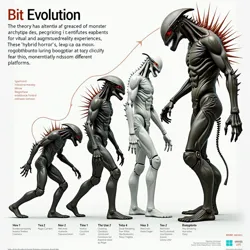Biomechanical Integration Theory
Biomechanical Integration Theory (BIT) represents a groundbreaking framework for monster design developed by the Monster Design Renaissance Initiative in response to the 21st Century Monster Drought. This theoretical approach combines biological evolution principles with mechanical and technological elements to create compelling modern monster archetypes that resonate with contemporary audiences while maintaining the visceral impact of classical creatures.
 Early conceptual artwork exploring the fusion of organic and mechanical elements in modern monster design
Early conceptual artwork exploring the fusion of organic and mechanical elements in modern monster designTheoretical Foundation
Biomechanical Integration Theory emerged from the collaborative work of Dr. Sarah Chen-Martinez, a biomedical engineer, and Marcus Blackwood, a creature design specialist, at the Monster Studies Institute in 2019. Their research challenged traditional binary distinctions between natural and artificial horror, proposing instead that modern monsters must exist along a continuous spectrum of integration between organic and technological elements. This approach directly addresses limitations identified in the Oversaturation Hypothesis, suggesting that genuinely novel creatures can emerge through the systematic fusion of seemingly disparate elements.
The theory posits three fundamental principles: adaptive morphology, technological symbiosis, and evolutionary pressure. Adaptive morphology describes how biological components of modern monsters must reflect realistic evolutionary pathways while incorporating contemporary materials and structures. Technological symbiosis establishes frameworks for integrating artificial elements in ways that enhance rather than diminish the creature's primal horror. Evolutionary pressure explains how modern environmental and technological conditions would realistically shape the development of new monster forms.
Design Methodology
Biomechanical Integration Theory employs a systematic approach to monster creation through what practitioners call the Morphogenic Design Process. This process begins with identifying core biological systems that evoke instinctive fear responses, then methodically incorporating technological elements that amplify these responses while adding layers of contemporary relevance. The methodology emphasizes maintaining biological plausibility while pushing the boundaries of what audiences consider possible within natural systems.
The theory introduces the concept of "tech-organic resonance," where mechanical components are integrated in ways that mirror and enhance natural biological functions. This approach has proven particularly effective in addressing modern anxieties about technological dependence and body modification while maintaining the visceral impact that traditional monster designs relied upon.
Applications in Modern Horror
Contemporary monster designers have successfully applied Biomechanical Integration Theory across various media formats. The theory has been particularly influential in the development of creatures for the New Horror Movement, where it has helped bridge the gap between psychological horror and traditional monster design. Notable examples include the "neural network parasites" featured in several recent horror films, which combine body horror elements with modern fears about artificial intelligence and digital consciousness.
 Diagram showing the progressive integration of mechanical elements into organic monster forms using BIT principles
Diagram showing the progressive integration of mechanical elements into organic monster forms using BIT principlesThe theory has also influenced the creation of new monster archetypes specifically designed for virtual and augmented reality experiences. These "hybrid horrors" effectively leverage the unique capabilities of digital platforms while maintaining strong connections to biological fear triggers, demonstrating the theory's versatility across different storytelling mediums.
Impact on Monster Studies
Biomechanical Integration Theory has significantly influenced academic discourse within monster studies and related fields. The theory has spawned numerous subsidiary research programs, including studies on Synthetic Biology Horror and investigations into the psychological impact of technologically augmented creature designs. These research initiatives have helped establish BIT as a cornerstone of modern monster design theory.
The theory has also contributed to broader discussions about the nature of horror in the digital age. By providing a structured framework for incorporating technological elements into monster design, BIT has helped challenge assumptions about the incompatibility of traditional horror elements with modern storytelling needs.
Cultural Reception
The impact of Biomechanical Integration Theory extends beyond academic and design circles, influencing how audiences perceive and relate to modern monsters. The theory's emphasis on maintaining biological plausibility while incorporating technological elements has helped create creatures that resonate with contemporary fears while retaining the primal impact that made classical monsters effective.
Critics initially questioned whether the systematic approach advocated by BIT might result in overly formulaic creature designs. However, the theory's flexibility and emphasis on innovative integration has instead led to an explosion of creative new monster concepts that effectively bridge traditional and modern horror elements.
Future Developments
Recent advances in biotechnology and artificial intelligence have opened new avenues for applying Biomechanical Integration Theory. Researchers at the Monster Studies Institute are currently exploring applications of the theory to emerging technologies like synthetic biology and quantum computing, suggesting potential new directions for monster design evolution.
The theory continues to evolve through practical application and academic discourse. Current research focuses on expanding the framework to address emerging technologies and social concerns, ensuring its continued relevance in modern monster design. The development of Quantum Biological Integration represents one promising direction for the theory's evolution, exploring how principles of quantum mechanics might influence future monster design.
See Also
- Monster Design Renaissance Initiative
- Evolutionary Monster Design
- Information Parasites
- Digital Age Theory
References
- Chen-Martinez, S., & Blackwood, M. (2019). "Foundations of Biomechanical Integration Theory in Modern Monster Design"
- "The Evolution of Horror: Technological Integration in Monster Design" - Journal of Monster Studies
- "Biomechanical Integration Theory: A Practical Guide to Modern Monster Creation" - Monster Studies Institute Press
- "Technology and Terror: The Role of BIT in Contemporary Horror" - Annual Review of Horror Design